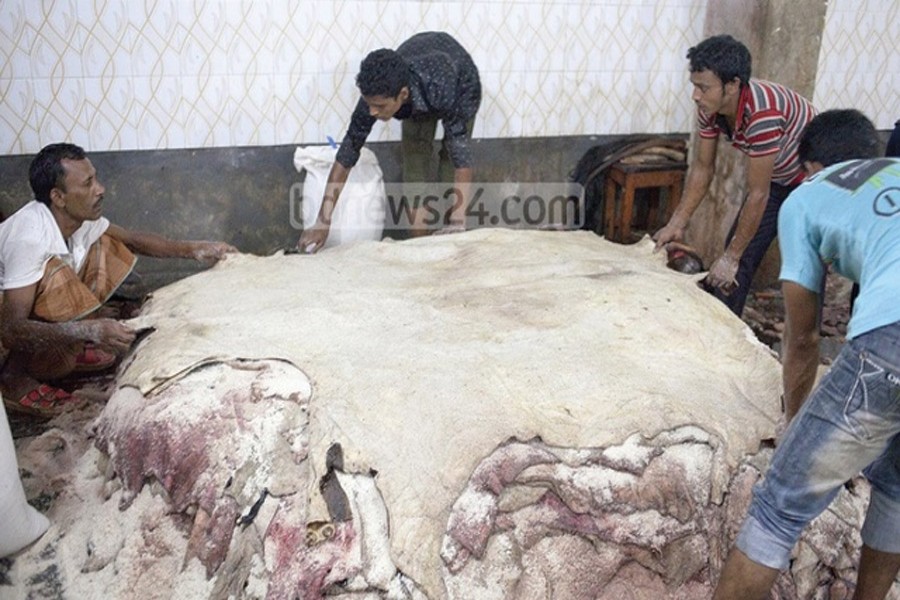Leather sector primed to become leader in export diversification

Published :
Updated :

With the upcoming Eid-ul Azha and the cattle madness that sweeps the nation, there will be the usual flurry of media coverage regarding the by-product that is the aftermath of the slaughter - the hide of the sacrificial animal. Eid-ul Azha is an important time for people in the trade as during the three days of Eid, 50 per cent of the raw hide needed by the leather sector for the entire year is collected. Additionally, it is also the time when the price of the raw hides for the year will be set. There will be the usual hue and cry regarding the shifting of tanneries, the incapacity of the Effluent Treatment Plant (ETP) in the new tannery area and the price of the raw hides being traded. However, we will only scratch the surface of the true issues of the sector. It is high time that more attention is paid to a sector that has been in existence since the birth of the country and is currently the second biggest export earner.
The tanneries of Bangladesh have been in business since pre-liberation time. They were primarily located in Hazaribagh. They have a place in the history of this country as one of the oldest industrial sector. Much has been said and written regarding the environmental aspects of the tannery trade. However, some of the best practices that have been in place since the sector's inception are never highlighted.
The tannery sector is still one of the oldest sectors with a functioning and established trade union. Despite being a high-risk work environment, it is a sector with excellent labour and management relationships and lower number of workplace-related injuries. This harmonious relationship has played a key role in supporting the relocation of the tanneries to the new tannery area. One of the major challenges that the tanneries faced was the relocation of the workforce.
The new tannery zone in Hemayetpur (Savar) has also had its share of controversy, with the major sore point being the suitability of the effluent treatment plants (ETP) to handle the waste being generated. There was also the issue of physical relocation which has taken a decade to be executed. Nevertheless, there are advancements taking place in the sector which are not coming to the limelight.
There are two Leather Working Group (LWG)-rated tanneries in Bangladesh which deserve recognition. LWG is a multi-stakeholder group seeking to improve the leather manufacturing industry by creating alignment on environmental priorities, bringing visibility to best practices and providing suggested guidelines for continual improvement.
The LWG is made up of member brands, retailers, product manufacturers, leather manufacturers, chemical suppliers, machinery suppliers, technical experts and other service providers that work together to maintain environmental stewardship protocols specifically for the leather manufacturing industry. Membership in LWG is considered as attaining international industrial benchmark in the leather sector.
Apex Footwear Ltd Tannery Unit has been a LWG-rated tannery since August 2015 and the newest member is Austan Limited. Austan Limited is a relatively new player in the leather sector and is an Australian investment in Bangladesh. The tannery also holds ISO 14001:2015 certification. It was able to achieve this through its commitment to effective environmental management systems.
Furthermore, the factories in the leather goods and footwear sector are national leaders in occupational and social compliance and corporate social responsibility (CSR) initiatives. The Leather Goods and Footwear Manufacturers & Exporters Association of Bangladesh (LFMEAB) require its member factories to pass the Association's external audit to grant membership and carry out annual audits as terms of membership renewal. The LFMEAB also undertakes various laudable "Beyond Compliance" initiatives within its member factories such as eye testing, tuberculosis screening and education on women's reproductive health which is directed not only towards the betterment of the workforce but has a positive multiplier effect on the community as well. One of the Association's member factories has also opened a community school with a focus on providing quality education.
Sufficient support needs to be provided to sectors which have the potential to boost export diversification. Due to the movements in international trade, especially with the current retaliatory trade climate between China and the US, Bangladesh is in a prime position to capture the manufacturing fallout from China. Competing countries such as Vietnam and Cambodia have already stepped up to attract investors in the leather sector. Vietnam, a country which historically did not manufacture any leather, has established 14 LWG-rated tanneries over the past five years. In 2018 Vietnam's leather and footwear sector had export turnover of US $19.5 billion and their target for 2019 is $ 21.5 billion.
The time is ripe for the leather sector to become a formidable player in the bid for export diversification. In addition to capturing larger share of existing markets, opportunities through favourable trade agreements should be sought in emerging markets such as Japan, China and Korea. Moreover, factors such as the ease of doing business, access to utilities and adequate infrastructure development should also be focused upon to attract potential investors in the sector. With the right policy support and proper addressing of the environmental issues, it is possible to achieve the leather sector's export target of $ 5.0 billion a year.
Amrita Makin Islam is Deputy Managing Director, Picard Bangladesh Ltd.


 For all latest news, follow The Financial Express Google News channel.
For all latest news, follow The Financial Express Google News channel.